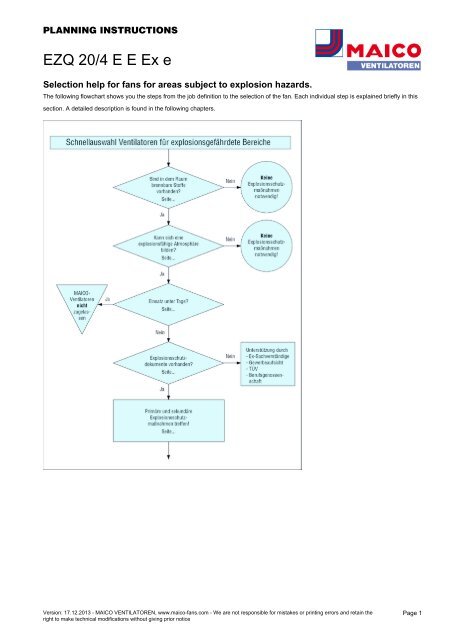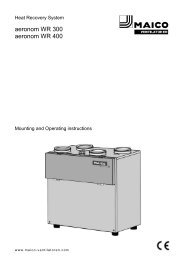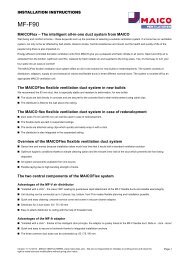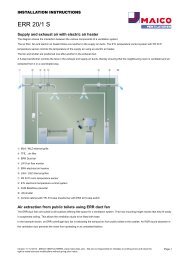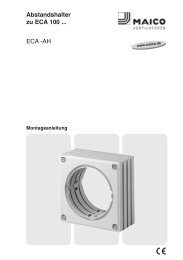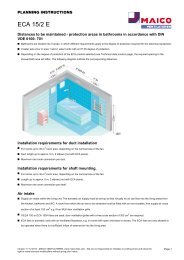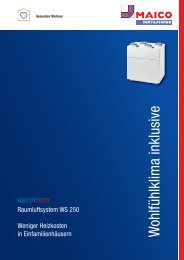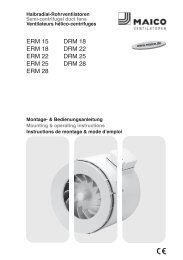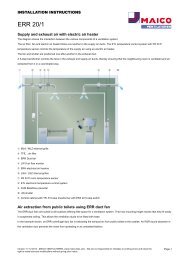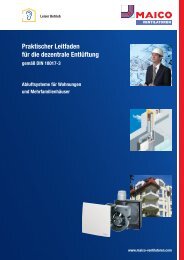EZQ 20/4 E E Ex e - Maico fans
EZQ 20/4 E E Ex e - Maico fans
EZQ 20/4 E E Ex e - Maico fans
You also want an ePaper? Increase the reach of your titles
YUMPU automatically turns print PDFs into web optimized ePapers that Google loves.
PLANNINGINSTRUCTIONS<strong>EZQ</strong> <strong>20</strong>/4 E E <strong>Ex</strong> eSelection help for <strong>fans</strong> for areas subject to explosion hazards.The following flowchart shows you the steps from the job definition to the selection of the fan. Each individual step is explained briefly in thissection. A detailed description is found in the following chapters.Version: 17.12.<strong>20</strong>13 - MAICO VENTILATOREN, www.maico-<strong>fans</strong>.com - We are not responsible for mistakes or printing errors and retain theright to make technical modifications without giving prior noticePage 1
PLANNINGINSTRUCTIONS<strong>EZQ</strong> <strong>20</strong>/4 E E <strong>Ex</strong> efor quick referenceStep 1:Are there combustible materials in the room?Page...Combustible materials are in particular all substances, which can be classified as flammable or highly inflammable. These can be gases,liquids and dust particles from combustible solid materials.<strong>Ex</strong>amples:■ Combustible gases: Liquid gas (butane, butene, propane, propene), natural gas, combustible gases (carbon monoxide, methane) or gasforming,combustible chemicals (acetylene, ethylene oxide, vinyl chloride)■ Combustible fluids: Solvents, fuels, crude oil, heating oil, lubrication oil or used oil, paint or non-water soluble chemicalsVersion: 17.12.<strong>20</strong>13 - MAICO VENTILATOREN, www.maico-<strong>fans</strong>.com - We are not responsible for mistakes or printing errors and retain theright to make technical modifications without giving prior noticePage 2
PLANNINGINSTRUCTIONS<strong>EZQ</strong> <strong>20</strong>/4 E E <strong>Ex</strong> e■ Dust particles from combustible solid materials Coal, wood, food and animal foodstuffs (sugar, flour, grain), man-made materials, metalsor chemicalsStep 2:Can there be a build up of an explosive atmosphere?Page ...A potentially explosive atmosphere is a mixture of air or oxygen with combustible gases, vapours, mists or dust under atmosphericconditions. When ignited, the combustion occurs throughout the complete, non-burned mixture. Locations where such a potentially explosiveatmosphere is present are known as areas subject to explosion hazards.Whether an explosion will occur or not when combustible materials are present, depends on the concentration and the "ignition qualities" ofthe air-mixture.<strong>Ex</strong>plosive atmospheres can build up when combustible materials are being stored, transported and processed.<strong>Ex</strong>amples:■ Spraying and splashing from a stream of liquid■ Vaporising and condensation of combustible liquids■ Leakages in gas or fluid piping■ Raising the dust of combustible solid materialsStep 3:Underground usage?Page ...Special regulations are in force for underground usage.MAICO <strong>fans</strong> are not suitable for usage underground.Step 4:Is there an <strong>Ex</strong>plosion Protection Document available?Page ...Whenever there is risk that a potentially explosive atmosphere may build up, an <strong>Ex</strong>plosion Protection Document must be created. Theremust be an overview of the results of the danger assessment and the resulting technical and organisational protection measures.This documentation must be created by the employer before work commences and it must contain the following information:■ Determining and assessing the risks of explosion■ Definitions of the implemented explosion protection measures■ Definitions of the zone classification■ Definitions of the design, operation and maintenance of the working and warning equipment used<strong>Ex</strong> specialists, trade supervisory boards, TÜV (German Technical Inspection Agency) or the employers' liability insurance associationprovide support during the creation of the <strong>Ex</strong>plosion Protection Document.Step 5:Take primary and secondary explosion protection measuresPage ...Version: 17.12.<strong>20</strong>13 - MAICO VENTILATOREN, www.maico-<strong>fans</strong>.com - We are not responsible for mistakes or printing errors and retain theright to make technical modifications without giving prior noticePage 3
PLANNINGINSTRUCTIONS<strong>EZQ</strong> <strong>20</strong>/4 E E <strong>Ex</strong> ePrimary explosion protection measures prevent the creation and the spreading of a potentially explosive atmosphere. The following areexamples of measures that could be used for this purpose:■ Diluent ventilation■ <strong>Ex</strong>traction■ The avoidance of combustible materialsSecondary explosion protection measures prevent the ignition of an explosive atmosphere. Ignition protection measures in both electricaland non-electrical resources are used for this purpose.Step 6:Which zones can the areas with explosive atmospheres be classified into?Page ...Areas at risk of explosion are sub-divided into Zones depending on the frequency and duration of explosive atmospheres. MAICO <strong>fans</strong> canbe used in Zones 1 and 2:■ Zone 1: An area where an explosive atmosphere consisting of a mixture of air and combustible gasses, vapours or mists can occur duringnormal operation.■ Zone 2: An area where an explosive atmosphere consisting of a mixture of air and combustible gases, vapours or mists normally doesn'toccur or only occurs short-term during normal operation.Step 7:Can the increased safety motor ignition protection type "e" be used?Page ...If the build-up of an explosive atmosphere cannot be prevented, the ignition of this explosive atmosphere is to be avoided. Possible sourcesof ignition are:■ Electrical equipment■ Static electricity■ Hot surfaces■ Mechanically generated sparks■ Flames and hot gasesElectrical equipment can have different levels of ignition protection. MAICO fan motors for areas at risk of explosion have the increasedsafety motor ignition protection type "e". This means that safety measures have been introduced at the motor to prevent the occurrence ofinadmissibly high temperatures or sparks.Step 8:Check present temperature class as well as air stream and ambient temperatures?Page ...The ignition temperature of a potentially explosive atmosphere is the lowest heated surface temperature at which ignition occurs. For thisreason, the maximum surface temperature of a piece of equipment (in the case of <strong>fans</strong>, this is the motor), must always be lower than theignition temperature of the explosive atmosphere in question.The temperature classes T1 to T6 define the maximum ignition temperature that a piece of equipment can be used at.MAICO <strong>fans</strong> are designed for use in different temperature classes, depending on the product type.Version: 17.12.<strong>20</strong>13 - MAICO VENTILATOREN, www.maico-<strong>fans</strong>.com - We are not responsible for mistakes or printing errors and retain theright to make technical modifications without giving prior noticePage 4
PLANNINGINSTRUCTIONS<strong>EZQ</strong> <strong>20</strong>/4 E E <strong>Ex</strong> eStep 9:Fan layoutPage ...There is a wide range of MAICO <strong>fans</strong> to choose from, based on the installation location and the point-of-use. There are <strong>fans</strong> for installation inducting systems as well as roof- and wall-mounted <strong>fans</strong>. The available air stream volumes range from 300 m 3 /h up to 11,000 m/h.Step 10:Is the build up of a potentially explosive atmosphere prevented in an approved way?Page ...It is critical that you check whether there is still the threat of a build-up of a potentially explosive atmosphere, in spite of all the primary andsecondary explosion protection measures. If this is the case, tertiary explosion protection measures must be taken. These should be aimedat reducing the effects of an explosion to a non-dangerous level.■ <strong>Ex</strong>plosion-proof construction■ Release of pressure■ Suppression of explosionIntroductionLegal requirementsThe regulations relating to explosion protection in Germany and in other member states of the European Union have migrated from theprevious EC <strong>Ex</strong> framework directives 76/117/EWG ff to new EC directives. With this step, explosion protection has been completelyharmonised within the European body of legislation and national regulations and guidelines have been adjusted to meet the legal demandswithin the European Union.The new legal system governing European explosion protection is based on two EC directives:■ Directive 94/9/EC: This defines the duties of the manufacturer in terms of the quality requirements for electrical and non-electricalequipment as well as protection systems.■ Directive 1999/92/EC: This regulates the duties for the operator (employer) in terms of the minimum requirements for the improvement ofthe protection of the health and security of employees, who could be placed in danger by explosive atmospheres.Duties of the manufacturer:Basically, safety in areas at danger from explosion can only be guaranteed through close cooperation between all concerned parties(manufacturers, installers, operators, test personnel, regulatory bodies).The manufacturer analyses and evaluates the ignition risks of his equipment and assigns them to the device groups and categories assdefined in Directive 94/9/EC, Appendix 1.■ <strong>Ex</strong>plosion protected <strong>fans</strong> from MAICO correspond to Device Group II, Category 2 G and when installed correctly, meet the basic safetyand health requirements.Version: 17.12.<strong>20</strong>13 - MAICO VENTILATOREN, www.maico-<strong>fans</strong>.com - We are not responsible for mistakes or printing errors and retain theright to make technical modifications without giving prior noticePage 5
PLANNINGINSTRUCTIONS<strong>EZQ</strong> <strong>20</strong>/4 E E <strong>Ex</strong> e■ The requirements for the application of the CE mark will be fulfilled within the scope of a conformity evaluation process.■ The equipment will be tested by an independent, recognised testing authority, which will confirm the conformity to the relevant regulationsby the issuing of an EC-Type-<strong>Ex</strong>amination certificate.■ Proof of a suitable QA system through an EC Certificate.Duties of the installer and the operatorThe Directive 1999/92/EC regulates the duties of the operator and/or employer, when there is likely to be a build-up of explosiveatmospheres. In particular, the following topics are handled, which are documented in the <strong>Ex</strong>plosion Protection Document (see Chapter 7).Prevention of and protection against explosions (Article 3)■ Prevention of the build-up of explosive atmospheres■ Avoidance of the ignition of explosive atmospheres■ Mitigation of detrimental effectsAssessment of explosion risks (Article 4)■ What is the likelihood that explosive atmospheres will occur?■ How long will the explosive atmosphere persist?■ Are there ignition sources present?■ Assessment of the installations, substances used, processes and their possible interactions.Implementing necessary measures for working in atmospheres at risk from explosion (Article 5)■ The design of a danger-free working environment■ Danger-free work through appropriate technical supervisionDuty of coordination (Article 6)■ Sub-contractors shall carry the responsibility for their own employees■ The employer of a sub-contractor's employees shall coordinate the implementation of all the measures concerning workers’ safety andshall give exact definitions in the <strong>Ex</strong>plosion Protection Document referred to in Article 8.Places where explosive atmospheres may occur (Article 7)■ The employer shall classify places where explosive atmospheres may occur into zones■ The employer shall ensure that the minimum requirements for the improvement of the safety and health of employees, placed at risk byexplosive atmospheres as laid down in Annex II are applied■ Areas subject to explosion hazards must be marked<strong>Ex</strong>plosion Protection Document (Article 8)The employer must ensure that an <strong>Ex</strong>plosion Protection Document is created and kept up-to-date. The <strong>Ex</strong>plosion Protection Document mustdemonstrate:■ that the explosion risks have been determined and assessed,■ that adequate measures have been taken,■ which areas have been classified into zones,■ which areas the minimum regulations according to Directive 1999/92/EC, Appendix II apply to.Special requirements for work equipment and workplaces (Article 9).Fans and their accessories, which were installed prior to 1st July <strong>20</strong>03 may continue to be used.Version: 17.12.<strong>20</strong>13 - MAICO VENTILATOREN, www.maico-<strong>fans</strong>.com - We are not responsible for mistakes or printing errors and retain theright to make technical modifications without giving prior noticePage 6
PLANNINGINSTRUCTIONS<strong>EZQ</strong> <strong>20</strong>/4 E E <strong>Ex</strong> eCombustible gases Combustible fluids Dust particles from combustible solidmaterialsLiquid gas (butane, butene, propane,propene)Natural gasCombustible gases, e.g. carbon monoxideor methaneGaseous combustible chemicals, e.g.acetylene, ethylenoxide, vinlychlorideSolventsFuel stuffsCrude, heating, lubricating or used oilPaintSoluble and non-water soluble chemicalsCoalWoodFood and animal foodstuffs, e.g sugar, flouror grainPlasticsMetalsChemicals<strong>Ex</strong>ample: Combustible materials can also occur unintentionally, e.g. when storing weak acids or leaching agents in metal containers. Thiscan result in the production of hydrogen and the build-up of gases.In general all materials that are capable of an exothermic oxidisation reaction should be considered as combustible. This includes inparticular all materials that are classified as flammable or highly inflammable according to the Materials Directive RL 67/548/EEC.There is a range of materials, which under normal conditions are very difficult to ignite. However when in very small particle sizes or whenthe ignition energy is hot enough, they become liable to exploded when mixed with air ( e.g. metal dust or aerosols).The ignition properties of an explosive atmosphere are material-dependant. Gases and vapours are sub-divided into 4 explosion groups inorder to differential the level of danger: I, IIA, IIB and IIC. The ignition properties and therefore the danger risks increase through the groupsfrom IIA to IIC.<strong>Ex</strong>plosion groupsCombustible materialsIMethaneIIAAcetonePetrolHeating oilIIBCity gasEthyleneIICHydrogenAcetylene<strong>Ex</strong>plosion group I only occurs in mining.This assignment is particularly significant for electrical equipment with the protection type pressure-proof housing "d" and inherent safety "i".[EXAM]<strong>Ex</strong>plosive atmosphereVersion: 17.12.<strong>20</strong>13 - MAICO VENTILATOREN, www.maico-<strong>fans</strong>.com - We are not responsible for mistakes or printing errors and retain theright to make technical modifications without giving prior noticePage 8
PLANNINGINSTRUCTIONS<strong>EZQ</strong> <strong>20</strong>/4 E E <strong>Ex</strong> eA potentially explosive atmosphere is a mixture of air or oxygen with flammable gases, vapours, mists or dusts under atmospheric conditions.In the event of ignition, combustion will spread to the entire non-combusted mixture.An area at risk of explosion is one where an explosive atmosphere could occur.An explosion can only occur when the concentration of combustible materials in the air is within a certain range. This so-called "explosionrange" is very dependant on the type of combustible material. The explosion range is defined by a lower (LEL) and an upper (UEL)concentration limit. An explosion can occur when the concentration is in between this two limit values. This can lead, for example, to thebuild-up of an explosive atmosphere in a partly filled petrol tank whereas a full one would not present any danger as the UEL would beexceeded.Version: 17.12.<strong>20</strong>13 - MAICO VENTILATOREN, www.maico-<strong>fans</strong>.com - We are not responsible for mistakes or printing errors and retain theright to make technical modifications without giving prior noticePage 9
PLANNINGINSTRUCTIONS<strong>EZQ</strong> <strong>20</strong>/4 E E <strong>Ex</strong> eApplication example: ERM ... E <strong>Ex</strong> e for air extraction of storage rooms with explosive atmospheresMAICO <strong>fans</strong> can be used for air extraction to bring the concentration of combustible gases under the explosion limit. Thisprevents the build-up of an explosive atmosphere.In the example shown, an ERM ... E EX e fan extracts gasses that are heavier than air. This is why the fan is installed close tothe ground.A potentially explosive atmosphere can occur above combustible materials through evaporation. The lowest temperature at which aspontaneously inflammable mixture of gas or vapour and air can occur above a liquid, under prescribed norm conditions is known as theflash point.A potentially explosive atmosphere can build up if the maximum possible room temperature is higher than the flash point of a combustibleliquid. [EXAM]T F - Flash point1 Combustible fluids2 Potentially explosive atmosphereBuild-up of a potentially explosive atmosphereIn principle, a potentially explosive atmosphere can occur during the production, storage, processing and transportation of combustiblematerials. [EXAM]■ Leakages in glass bottles or gas pipes■ Evaporation of combustible liquids at temperatures above the flash point■ Spraying, splashing or breaking a stream of liquid.Version: 17.12.<strong>20</strong>13 - MAICO VENTILATOREN, www.maico-<strong>fans</strong>.com - We are not responsible for mistakes or printing errors and retain theright to make technical modifications without giving prior noticePage 10
PLANNINGINSTRUCTIONS<strong>EZQ</strong> <strong>20</strong>/4 E E <strong>Ex</strong> e■ If the liquid is spread in drops, a potentially explosive atmosphere can build-up, even at ambient temperatures below the flash point.Application example: Wall <strong>fans</strong> for air extractionThe build-up of an potentially explosive atmosphere from combustible liquids can be avoided by air extraction. In this case,DZQ...E <strong>Ex</strong>e wall <strong>fans</strong> are used for extraction, at the point where the air/gas mixture build-up can occur.■ Leakages from pipes carrying liquids■ If there are leakages in the enclosure of combustible liquids with high excess pressure, the liquid can spray out and form an explosivemist, depending on the size of the leak and the level of pressure. This can then turn into explosive vapours.Version: 17.12.<strong>20</strong>13 - MAICO VENTILATOREN, www.maico-<strong>fans</strong>.com - We are not responsible for mistakes or printing errors and retain theright to make technical modifications without giving prior noticePage 11
PLANNINGINSTRUCTIONS<strong>EZQ</strong> <strong>20</strong>/4 E E <strong>Ex</strong> eFans Temperature class Useable?DZD 25/4 A-<strong>Ex</strong> T1 to T4 xDZD 30/6 A-<strong>Ex</strong> T1 to T4 xDZD 30/4 A-<strong>Ex</strong> T1 to T4 xDZD 30/2 A-<strong>Ex</strong>T1 to T3DZD 35/6 A-<strong>Ex</strong> T1 to T4 xDZD 35/4 A-<strong>Ex</strong> T1 to T4 xDZD 35/2 A-<strong>Ex</strong>T1 to T3DZD 40/6 A-<strong>Ex</strong> T1 to T4 xDZD 40/4 A-<strong>Ex</strong> T1 to T4 xDZD 50/6 A-<strong>Ex</strong> T1 to T4 xDZD 50/4 A-<strong>Ex</strong>T1 to T3DZD 60/6 A-<strong>Ex</strong>T1 to T3■ Grinding or sifting■ Conveying, filling or emptyingApplication example: ERM 22 E <strong>Ex</strong> e airstreamsThe ERM 22 E <strong>Ex</strong> e fan is approved for use with temperature classes T1 to T3. For this reason, it can be used to convey anexplosive atmosphere with an ignition temperature greater than <strong>20</strong>0 °C.Therefore this fan can be used, for example, to convey petrol, diesel or heating oil vapours.■ DryingTemperature classI IIA IIB IIC\explosion groupT1 Methane AcetoneEthaneCity gasHydrogenVersion: 17.12.<strong>20</strong>13 - MAICO VENTILATOREN, www.maico-<strong>fans</strong>.com - We are not responsible for mistakes or printing errors and retain theright to make technical modifications without giving prior noticePage 12
PLANNINGINSTRUCTIONS<strong>EZQ</strong> <strong>20</strong>/4 E E <strong>Ex</strong> eTemperature classI IIA IIB IIC\explosion groupPropaneT2N-butaneEthyleneAcetyleneN-butyl alcoholEthyl alcoholT3Heating oilDieselPetrolT4AcetaldehydeEthyl etherT5T6Carbon disulphide■ Stirring up of dustTemperature classesThe ignition temperature is the lowest temperature of a surface, e.g. of electric motors, at which an explosive atmosphere ignites on thatsurface.Version: 17.12.<strong>20</strong>13 - MAICO VENTILATOREN, www.maico-<strong>fans</strong>.com - We are not responsible for mistakes or printing errors and retain theright to make technical modifications without giving prior noticePage 13
PLANNINGINSTRUCTIONS<strong>EZQ</strong> <strong>20</strong>/4 E E <strong>Ex</strong> ePotentially explosive substances can be classified into temperature classes by their ignition temperatures. The maximum surfacetemperature of a piece of equipment (the motor in the case of <strong>fans</strong>) must always be below the ignition temperature of the explosiveatmosphere in which it is used.T Z - Ignition temperatureEquipment that falls into a higher temperature class, e.g. T4, may also be used for applications in which a lower temperature class isrequired e.g. T2 or T3.<strong>Ex</strong>ample: An electric motor with a surface temperature of 175°C may be used only in the potentially explosive atmosphere of temperatureclasses T1, T2 and T3.The following table assigns a range of flammable gases to a temperature class and explosion group.Key parameters of a potentially explosive atmosphereA potentially explosive atmosphere is characterised by:■ The potentially explosive substance it contains■ The concentration of that substance■ The flash point and ignition temperature■ The temperature classThese parameters must be known in order to be able to assess the risk of explosion and the corresponding explosion protection measures.Key parameters of electrical operating equipment and systems in the area subject toexplosion hazardsDevice groups and device categoriesElectrical equipment for use in potentially explosive atmospheres is divided into 2 device groups:■ Group I: Electrical operating equipment used underground where there is a risk of firedamp (not included in the MAICO product range).■ Group II: Electrical equipment in all other areas subject to explosion hazards. These are then further sub-divided into three categories 1, 2and 3, dependant on the level of danger.Version: 17.12.<strong>20</strong>13 - MAICO VENTILATOREN, www.maico-<strong>fans</strong>.com - We are not responsible for mistakes or printing errors and retain theright to make technical modifications without giving prior noticePage 14
PLANNINGINSTRUCTIONS<strong>EZQ</strong> <strong>20</strong>/4 E E <strong>Ex</strong> eEquipment from Device group II are given a letter, which identifies the state of the atmosphere:■ G - for areas in which explosive gas-, vapour- or mist-air mixtures are present. These are applications where MAICO <strong>fans</strong> can be used.■ D - for areas in which dust mixed with air can cause the build up of an explosive atmosphere. These are not applications where MAICO<strong>fans</strong> can be used.ZoneAggregation state of the combustiblematerialFrequency with which a potentiallyexplosive atmosphere occurs0 Gas, vapour, mist Constantly, for long periods or frequently1 Gas, vapour, mist Occasionally2 Gas, vapour, mist Seldom and for short periods<strong>20</strong> Dust Constantly, for long periods or frequently21 Dust Occasionally22 Dust Seldom and for short periodsClassification of zonesAreas subject to explosion hazards are classified into zones according to the frequency with which potentially explosive atmospheres occur.A differentiation is also made between gas/vapour and dust according to the aggregate status of the inflammable substance.Version: 17.12.<strong>20</strong>13 - MAICO VENTILATOREN, www.maico-<strong>fans</strong>.com - We are not responsible for mistakes or printing errors and retain theright to make technical modifications without giving prior noticePage 15
PLANNINGINSTRUCTIONS<strong>EZQ</strong> <strong>20</strong>/4 E E <strong>Ex</strong> eUsage example: MAICO <strong>fans</strong> in Zone 1 and Zone 2In the graphic shown, representing production and storage areas, the operator has divided the area into zones 0, 1 and 2.The concentration of combustible material in the air is reduced through constant cross-ventilation. This reduces the explosionhazard.MAICO wall <strong>fans</strong> <strong>EZQ</strong> ... E <strong>Ex</strong> e or DZQ ... E <strong>Ex</strong> e are installed for this purpose in zone 1 and zone 2.Equipment for Zone 1 may also be used in Zone 2.All MAICO <strong>fans</strong> approved for use in areas subject to explosion hazards may be used in Zones 1 and 2.Key parameters of electrical operating equipment and systems in the area subject toexplosion hazards<strong>Ex</strong>plosion protection<strong>Ex</strong>plosion protection measuresThere are three levels of explosion protection:■ Primary explosion protection: Avoidance of the build-up of explosive atmospheres■ Secondary explosion protection: Avoidance of sources of ignition■ Tertiary explosion protection: Prevention of the spread of an explosion and the reduction of the effects of an explosion.An integrated explosion protection concept should be used:The primary measures to be adopted should be aimed at the avoidance of explosive atmospheres. Only when the build-up of suchatmospheres cannot be avoided in spite of protection measures should the attention turn to measures to avoid sources of ignition. If thesecannot be completely ruled out, measures to prevent the spread of an explosion must be taken.Primary explosion protectionThere is a range of measures that can be taken to avoid the build-up of explosive atmospheres:■ Ventilation (extraction, air-thinning)■ Replace combustible materials with safe ones■ InertisationVersion: 17.12.<strong>20</strong>13 - MAICO VENTILATOREN, www.maico-<strong>fans</strong>.com - We are not responsible for mistakes or printing errors and retain theright to make technical modifications without giving prior noticePage 16
PLANNINGINSTRUCTIONS<strong>EZQ</strong> <strong>20</strong>/4 E E <strong>Ex</strong> eVentilation as the central measure for primary explosion protectionIf it is not possible to exclude the use of combustible materials, the build-up of a potentially explosive atmospheres can often be avoided withsuitable ventilation measures. Gases and dust are only explosive when the mixture with air falls within certain concentration levels.The use of suitable ventilation equipment can often result in bringing the concentration below the lower explosion level, which in turn is areliable method of preventing the build-up of explosive atmospheres. In any case, the probability of them occurring or the scope of areas atrisk of explosion (zones) is reduced.Applications for ventilation equipment in areas subject to explosion hazardsTypical applications for ventilation equipment in areas subject to explosion hazards are:■ Storage facilities■ Process technical applications■ Workshops■ Petro-chemicals■ Battery rooms■ LaboratoriesBasically in such cases, a ventilation system is always necessary to convey the combustible gasses, vapours or mist from the explosiveatmosphere out of the building.Version: 17.12.<strong>20</strong>13 - MAICO VENTILATOREN, www.maico-<strong>fans</strong>.com - We are not responsible for mistakes or printing errors and retain theright to make technical modifications without giving prior noticePage 17
PLANNINGINSTRUCTIONS<strong>EZQ</strong> <strong>20</strong>/4 E E <strong>Ex</strong> eAn addition ventilation system may be necessary, depending on the application. Otherwise the naturally generated fresh air supply throughthe ventilation grill or shutters is enough.Ventilation at the point of exit, e.g. rim extraction with open containers, to prevent the dispersion of explosive material into the room.1 Ventilation duct, to be supplied by the customer2 ELM ... <strong>Ex</strong> Fixing cuff3 ERM ... E <strong>Ex</strong> e fanSGM ... <strong>Ex</strong> Protective grille1 Potentially explosive atmosphereVersion: 17.12.<strong>20</strong>13 - MAICO VENTILATOREN, www.maico-<strong>fans</strong>.com - We are not responsible for mistakes or printing errors and retain theright to make technical modifications without giving prior noticePage 18
PLANNINGINSTRUCTIONS<strong>EZQ</strong> <strong>20</strong>/4 E E <strong>Ex</strong> eBy distributing the combustible material through the air, concentration levels can be reduced such that they are below the lower explosionlevel. The lower explosion level is the lowest concentration level value of a combustible material in a mixture of gases, vapours, mist or dust,below which it is no longer possible for flames to propagate themselves independently after an ignition source has been ignited.1 MLA or MLZ external grille2 Potentially explosive atmosphere<strong>EZQ</strong> ... E <strong>Ex</strong> e or DZQ ... E <strong>Ex</strong> e fanTechnical implementation of ventilation systems in areas subject to explosion hazards<strong>Ex</strong>perience shows that you should try to achieve air exchange rates of at least 5 1/h in areas at risk of explosion. The corresponding valuesfor specific individual cases are given through Employers' liability insurance association or other regulations.Further, you must ensure that the air limit values, e.g. maximum workplace concentration values, for all gases, vapours and mist that mayoccur are adhered to.For this reason, it is often advisable to install an active ventilation system for the affected rooms in addition to the air extraction or exhaustair system. If required, lower levels of overpressure or negative pressure can be achieved through suitable control of air flows for the outsideand outgoing air. There should always be negative pressure in rooms with areas subject to explosion hazards.Therefore, the mass flow in the supply air pipes should be slightly smaller than that in the exhaust ducts.Depending on the application, there are many different options for the location of the supply and exhaust air <strong>fans</strong>, the ventilation ducting, thesupply and exhaust air openings, etc.A range of technical measures have proved themselves for achieving effective ventilation:With cross-ventilation, the supply air flows through the whole room before being extracted again.Version: 17.12.<strong>20</strong>13 - MAICO VENTILATOREN, www.maico-<strong>fans</strong>.com - We are not responsible for mistakes or printing errors and retain theright to make technical modifications without giving prior noticePage 19
PLANNINGINSTRUCTIONS<strong>EZQ</strong> <strong>20</strong>/4 E E <strong>Ex</strong> eIn this case, the supply air should be blown in near to and parallel to the ceiling. The induction effect then distributes the supply airthroughout the whole room.<strong>Ex</strong>haust air should be extracted at floor level as most combustible gases and vapours are heavier than air. The exception to this is hydrogen,which collects under the ceiling. Please refer in this case to the following usage example: "Cross-ventilation in battery rooms".1 <strong>EZQ</strong> ... E <strong>Ex</strong> e or DZQ ... E <strong>Ex</strong> e wall-mounted fan2 Air flow with cross-ventilation3 Potentially explosive atmosphere4 ERM ... E <strong>Ex</strong> e duct fan1 Outgoing air2 DZD ... E <strong>Ex</strong> e roof fan3 Air flow with cross-ventilation4 Potentially explosive atmosphere5 ERM ... E <strong>Ex</strong> e duct fan6 ERM ... E <strong>Ex</strong> e duct fanIn the application shown above, the supply air is blown into the room parallel to the ceiling. This supply air is mixed well with the air already inthe room as it makes its way across the room.Air extraction is then done direct at the workplace, in a dangerous material cabinet with a fan connected directly to it or generally throughextractor <strong>fans</strong> at floor level.Supply should be introduced through cross-ventilation in order to create as little disturbance as possible.In order to keep pressure loss at the supply air opening as low as possible, the free cross section of the supply air opening should be at least3 or 4 times that of the fan. This can be done with one opening of a suitable size or through several smaller ones.The MAICO MLA and MLZ external grilles, size <strong>20</strong> to 50, can be used.MAICO recommends the use of the automatic AS shutter, size <strong>20</strong> to 60, with external shutters.Version: 17.12.<strong>20</strong>13 - MAICO VENTILATOREN, www.maico-<strong>fans</strong>.com - We are not responsible for mistakes or printing errors and retain theright to make technical modifications without giving prior noticePage <strong>20</strong>
PLANNINGINSTRUCTIONS<strong>EZQ</strong> <strong>20</strong>/4 E E <strong>Ex</strong> eApplication example:Cross-ventilation in battery roomsHydrogen is produced in battery rooms while the cells are being charged, which collects under the ceiling. At the same time,sulphuric acid mist collects at floor level with lead batteries. Both of these must be extracted.For this purpose, equip the exhaust air system with openings both at floor and ceiling level or extract the exhaust air directlywith <strong>EZQ</strong> ... E <strong>Ex</strong> e or DZQ ... E <strong>Ex</strong> e wall <strong>fans</strong>.Supply air is introduced through a separate ventilation system at the the other end of the battery room. If possible the simplestsolution in this case is the use of <strong>EZQ</strong> ... E <strong>Ex</strong> e or DZQ ... E <strong>Ex</strong> e wall <strong>fans</strong> to blow air from outside into the room.The RS shutter may only be used if the corresponding MS 2 servomotor is installed outside the area subject to explosion hazards.Additionally, MAICO offers an extensive range of system components and accessories for ventilation systems for use in areas subject toexplosion hazards.1 MLA or MLZ external grille2 ERM ... E <strong>Ex</strong> e duct fan3 Supply air opening4 Potentially explosive atmosphere5 <strong>Ex</strong>haust air exit opening6 DZD ... E <strong>Ex</strong> e roof fanThe expelling of exhaust air from the building must meet different requirements, depending on the industry. For example, the following rulesare valid for the treatment of exhaust air in the paint industry:■ The exhaust air opening must be at least 2 metres above the ridge of a gable roof or 5 metres above a flat roof.■ The exhaust air opening must be at least 10 metres above the ground.■ The exhaust air exit speed must be at least 7 m/s.■ In the case of extraction equipment, there must be a suitable run-on time in order to ensure that there cannot be a build-up of anexplosive atmosphere, even after the actual work itself has been completed.Folded, spiral ducting is suitable for use as the ventilation piping.Plastic ducting should not be used because of the danger of electro-static discharge. Special plastic ducting that can conduct electricity mayhowever be used.1 Potentially explosive atmosphereGaseous inert materialDustlike inert materialNitrogenCarbon dioxideInert gases (Helium, Neon, Argon)Combustible exhaust fumesStone dustCalcium sulphateAmmonia phosphateSodium bicarbonateWater vapour1 <strong>Ex</strong>haust air exit opening2 DZD ... E <strong>Ex</strong> e roof fan3 ERM ... E <strong>Ex</strong> e duct fan4 Outgoing airVersion: 17.12.<strong>20</strong>13 - MAICO VENTILATOREN, www.maico-<strong>fans</strong>.com - We are not responsible for mistakes or printing errors and retain theright to make technical modifications without giving prior noticePage 21
PLANNINGINSTRUCTIONS<strong>EZQ</strong> <strong>20</strong>/4 E E <strong>Ex</strong> eReplacement of combustible materialThe build-up of potentially dangerous, explosive atmospheres can be prevented by the avoidance of or the reduction in the use ofcombustible materials. One example for this is the replacement of combustible solvents or cleaning agents by water-based solutions.Another option is to dampen the dust or to use highly viscous products, so that it is no longer possible to disturb the dust. [EXAM]InertisationA potentially dangerous, explosive atmosphere can also be avoided by thinning the oxygen in the air inside the equipment or by thinning thefuel with chemical, non-reactive (inert) material. This protective measure is known as inertisation. [EXAM]As a rule, inertisation by the use of gases can only be used in closed equipment, where only a relatively limited gas volume exchange perunit is possible.If an inert gas escapes from the equipment through openings that are normally there or that are caused by an error, this can represent adanger to the operator by reducing the level of oxygen and increasing the risk of suffocation. If combustion gasses are used as inert gasses,an escape of gas in this case can lead to the operator being poisoned.Secondary explosion protectionIf it is not possible to prevent the build-up of an explosive atmosphere, measures must be implemented to avoid the igniting of the explosiveatmosphere. This is achieved by measures that avoid the occurrence of ignition sources.The various types of ignition sources and their effects must be known, in order to define effective protective measures.Ignition sourcesThe following ignition sources can occur in commercial and industrial operations:■ Hot surfaces■ e.g. radiators, cooker hobs, heating boiler, heated machine parts, ...■ Flames and hot gases■ e.g. Bunsen burners, candles, matches, open-flame heating■ Mechanically generated sparks■ Electrical equipment:■ Opening and closing electrical circuits, e.g. light switches, electrical motors, switching on a refrigerator, heating system burnersApplication example: Ignition protection concept, with AC motor <strong>fans</strong> from MAICOThe potential source of ignition with MAICO <strong>fans</strong> is their hot surfaces.This is caused by the dissipated energy from the motor.In normal operation, the surface temperature reaches a stable level after some time. In the case of malfunctions, e.g. a blockedimpeller, this temperature can rise significantly in a very few seconds. Without appropriate protective measures, the ignitiontemperature of an explosive atmosphere could be exceeded and as a result, an explosion could be triggered.The protective measures are based on monitoring the temperature of the motor. For this purpose, there are PTC thermistorsbuilt into the motor winding, which are connected to a separate MVS 6 triggering device. When a particular maximumtemperature is exceeded, the MVS 6 switches the fan off, giving you a reliable way of preventing an ignition temperature levelbeing reached.Further protective measures have been implemented in the external, mechanical parts of the fan. These address in particularfriction with rotating parts, the build-up of static electricity and the unit's flammability.Version: 17.12.<strong>20</strong>13 - MAICO VENTILATOREN, www.maico-<strong>fans</strong>.com - We are not responsible for mistakes or printing errors and retain theright to make technical modifications without giving prior noticePage 22
PLANNINGINSTRUCTIONS<strong>EZQ</strong> <strong>20</strong>/4 E E <strong>Ex</strong> e■ Sparks caused by friction, grinding or striking, e.g. nailed shoes on cement, rusty iron on aluminium, hammer on metal. There are tools,e.g. sockets sets made of material that does not generate sparks.Type of protection Function principle Main application"e"Increased safetySafety measures have beenintroduced to prevent theoccurrence of inadmissibly hightemperatures or sparks in theinner or outer parts.Terminal boxes, motors, lights"d"Pressure-proof housingParts that could ignite anexplosive atmosphere areinstalled in a housing that canwithstand the pressure of anexplosion and prevents transferto the surrounding explosiveatmosphere.Switching devices, motors,transformers, heaters"p"PressurisationThe build-up of an explosiveatmosphere within the housingis prevented by an ignitionprotection gas, which maintainsan excess pressure higherthan that of the surroundingatmosphere.Switching and control cabinets,analysis equipment, largemotors"i"Intrinsic safetyThe equipment containsintrinsically safe power circuits,which guarantee that nosparks or thermal effects cancause the ignition of explosiveatmospheres.Measurement and controltechnology, communicationstechnology, sensors"q"Powder fillingParts which could become asource of ignition are fixedin their position and thencompletely surrounded with afilling agent, in order to preventthe ignition of an externalexplosive atmosphere.CapacitorsVersion: 17.12.<strong>20</strong>13 - MAICO VENTILATOREN, www.maico-<strong>fans</strong>.com - We are not responsible for mistakes or printing errors and retain theright to make technical modifications without giving prior noticePage 23
PLANNINGINSTRUCTIONS<strong>EZQ</strong> <strong>20</strong>/4 E E <strong>Ex</strong> eType of protection Function principle Main application"o"Oil immersionParts which could becomea source of ignition arecompletely surrounded witha protective liquid, e.g. oil, inorder to prevent the ignitionof an external explosiveatmosphere.Starting resistances,transformers"m"EncapsulationParts which could becomea source of ignition arecompletely surrounded witha casting compound, in orderto prevent the ignition of anexternal explosive atmosphere.Sensors, switching devices■ Electrical circulating current, cathodic corrosion protection:■ Stray and leakage current in electrically conductive equipment■ Static electricity:■ Discharge sparks when coming into contact with charged parts because of a potential difference, e, g. charging of plastic materials■ Lightningand non-conductive liquidsElectrical equipment protection types as measures in secondary explosion protectionCostly pressure-proof housing is not necessary with equipment where no ignition is expected during normal operation, e.g. all MAICO <strong>fans</strong>designed for use in areas subject to explosion hazards.MAICO <strong>fans</strong> for these applications are constructed with the increased safety protection type "e", which can achieve the same level of securityas pressure-proof housing.Tertiary explosion protectionTertiary explosion protection is measures that are taken to reduce the effect of an explosion to a non-dangerous level. This means that theexplosion actually occurs but its dangerous effects are restricted by the implementation of the corresponding measures.Such measures could be:■ <strong>Ex</strong>plosion-proof construction■ Release of pressure■ Suppression of explosionMAICO fan selection guideMAICO <strong>fans</strong>, for use in areas subject to explosion hazardsThe following details must be known, in order to select the suitable fan:Version: 17.12.<strong>20</strong>13 - MAICO VENTILATOREN, www.maico-<strong>fans</strong>.com - We are not responsible for mistakes or printing errors and retain theright to make technical modifications without giving prior noticePage 24
PLANNINGINSTRUCTIONS<strong>EZQ</strong> <strong>20</strong>/4 E E <strong>Ex</strong> eMAICO offers:Valid for:Device groupDevice group II, Category 2 Gi.e. suitable for explosive atmosphereswith gases, vapours and mists, other thanminingAll <strong>Ex</strong>-fan product groups.Zone Approved for Zone 1 and Zone 2All <strong>Ex</strong>-fan product groups.Not approved for use in dusty areassubject to explosion hazards (zones 21. 21.22).Type of protection Increased safety "e" All <strong>Ex</strong>-fan product groups.Installation siteFans for installation in ceilings, walls orductsCorresponding product groupPoint of workRoof <strong>fans</strong>:DZD ... E <strong>Ex</strong> e800 m 3 /h up to 7100 m 3 / hWall <strong>fans</strong>:<strong>EZQ</strong> ... E <strong>Ex</strong> e, DZQ ... E <strong>Ex</strong> e400 m 3 /h up to 10400 m 3 / hDuct <strong>fans</strong>:DZR ... E <strong>Ex</strong> e1100 m 3 /h up to 10500 m 3 / hDuct <strong>fans</strong>:ERM ... E <strong>Ex</strong> e300 m 3 /h up to 900 m 3 / hCorresponding product groupTemperature class Depending on product type T1 - T3 to T1 -Corresponding product typeT5Additionally, the following factors play a role in the selection of the correct fan:MAICO offers:Valid for:Air mediumVapours that are neutral or that have aslight acidic or alkaline contentAll <strong>Ex</strong>-fan product groups.Maximum airstream temperature 50°C All <strong>Ex</strong>-fan product groups.Version: 17.12.<strong>20</strong>13 - MAICO VENTILATOREN, www.maico-<strong>fans</strong>.com - We are not responsible for mistakes or printing errors and retain theright to make technical modifications without giving prior noticePage 25
PLANNINGINSTRUCTIONS<strong>EZQ</strong> <strong>20</strong>/4 E E <strong>Ex</strong> eMAICO offers:Valid for:Rated voltage400 V230 VDZQ / DZR / DZD ... E <strong>Ex</strong> eERM... E <strong>Ex</strong> e, <strong>EZQ</strong> ... E <strong>Ex</strong> eSpeed controllableYesNoDZQ / DZR / DZD ... E <strong>Ex</strong> eERM... E <strong>Ex</strong> e, <strong>EZQ</strong> ... E <strong>Ex</strong> eApplication exampleA fan is required for the following area subject to explosion hazards:■ Zone 1■ Ignition temperature 150°C - corresponds to temperature class T4■ Installation location roofAll MAICO <strong>fans</strong> for use in areas at risk of explosion may be used in Zone 1.All DZD-...<strong>Ex</strong> roof <strong>fans</strong> highlighted in the following table may be used in temperature class T4:ERM... semi-centrifugal duct <strong>fans</strong> E <strong>Ex</strong> eAC model■ Not speed-controllable■ Compact construction for space-saving installation■ Can be fitted in any positionProduct type Temperature class Rotating speedmin -1Air volume:m 3 / hNominal sizemmERM 18 E <strong>Ex</strong> e T1 to T4 2780 310 180ERM 22 E <strong>Ex</strong> e T1 to T3 2860 560 225ERM 25 E <strong>Ex</strong> e T1 to T3 2860 870 250Version: 17.12.<strong>20</strong>13 - MAICO VENTILATOREN, www.maico-<strong>fans</strong>.com - We are not responsible for mistakes or printing errors and retain theright to make technical modifications without giving prior noticePage 26
PLANNINGINSTRUCTIONS<strong>EZQ</strong> <strong>20</strong>/4 E E <strong>Ex</strong> eA - ERM 18 E <strong>Ex</strong> eB - ERM 22 E <strong>Ex</strong> eC - ERM 25 E <strong>Ex</strong> e<strong>Ex</strong>tensive product information (tender text, technical data, prices, etc.) can be found under www.maico -ventilatoren.com .If you have technical questions, please use our Service Hotline:Phone: 0 18 05 / 69 41 10Fax: 0 77 <strong>20</strong> / 69 42 39DZR ... axial duct <strong>fans</strong> E <strong>Ex</strong> eThree-phase AC version■ Speed-controllable with transformers■ Duct sleeve made of galvanised sheet-steel, with flanges on both sides.■ Switchable for ventilation and air extraction■ Can be fitted in any position■ Connect the built-in temperature sensor resistor to a tested resistor triggering device.■ We reserve the right to make technical modifications.Version: 17.12.<strong>20</strong>13 - MAICO VENTILATOREN, www.maico-<strong>fans</strong>.com - We are not responsible for mistakes or printing errors and retain theright to make technical modifications without giving prior noticePage 27
PLANNINGINSTRUCTIONS<strong>EZQ</strong> <strong>20</strong>/4 E E <strong>Ex</strong> eProduct type Temperature class Rotating speedmin -1Air volume:m 3 / hNominal sizemmDZR <strong>20</strong>/2 B E <strong>Ex</strong> e 29<strong>20</strong> 1150 <strong>20</strong>0DZR 25/4 B E <strong>Ex</strong> e 1470 1100 250DZR 25/2 B E <strong>Ex</strong> e 2835 2<strong>20</strong>0 250DZR 30/6 B E <strong>Ex</strong> e 992 1250 300DZR 30/4 B E <strong>Ex</strong> e 1445 1950 300DZR 30/2 B E <strong>Ex</strong> e 2730 3800 300DZR 35/6 B E <strong>Ex</strong> e 985 1850 350DZR 35/4 B E <strong>Ex</strong> e 1390 2800 350DZR 35/2 B E <strong>Ex</strong> e 2750 6000 350DZR 40/6 B E <strong>Ex</strong> e 975 2800 400DZR 40/4 B E <strong>Ex</strong> e 14<strong>20</strong> 4400 400DZR 45/6 B E <strong>Ex</strong> e 960 4500 450DZR 45/4 B E <strong>Ex</strong> e 13<strong>20</strong> 6500 450DZR 50/6 B E <strong>Ex</strong> e 9<strong>20</strong> 5800 500DZR 50/4 B E <strong>Ex</strong> e 1360 9100 500DZR 60/6 B E <strong>Ex</strong> e 890 10500 600<strong>Ex</strong>tensive product information (tender text, technical data, prices, etc.) can be found under www.maico-ventilatoren.com .If you have technical questions, please use our Service Hotline:Phone: 0 18 05 / 69 41 10Fax: 0 77 <strong>20</strong> / 69 42 39Version: 17.12.<strong>20</strong>13 - MAICO VENTILATOREN, www.maico-<strong>fans</strong>.com - We are not responsible for mistakes or printing errors and retain theright to make technical modifications without giving prior noticePage 28
PLANNINGINSTRUCTIONS<strong>EZQ</strong> <strong>20</strong>/4 E E <strong>Ex</strong> eA - DZR 30/6 B E <strong>Ex</strong> eB - DZR 25/4 B E <strong>Ex</strong> eC - DZR <strong>20</strong>/2 B E <strong>Ex</strong> eD - DZR 25/2 B E <strong>Ex</strong> eA - DZR 35/6 B E <strong>Ex</strong> eB - DZR 30/4 B E <strong>Ex</strong> eC - DZR 35/4 B E <strong>Ex</strong> eD - DZR 30/2 B E <strong>Ex</strong> eVersion: 17.12.<strong>20</strong>13 - MAICO VENTILATOREN, www.maico-<strong>fans</strong>.com - We are not responsible for mistakes or printing errors and retain theright to make technical modifications without giving prior noticePage 29
PLANNINGINSTRUCTIONS<strong>EZQ</strong> <strong>20</strong>/4 E E <strong>Ex</strong> eA - DZR 40/6 B E <strong>Ex</strong> eB - DZR 45/6 B E <strong>Ex</strong> eC - DZR 40/4 B E <strong>Ex</strong> eD - DZR 35/2 B E <strong>Ex</strong> eA - DZR 50/6 B E <strong>Ex</strong> eB - DZR 60/6 B E <strong>Ex</strong> eC - DZR 45/4 B E <strong>Ex</strong> eD - DZR 50/4 B E <strong>Ex</strong> eVersion: 17.12.<strong>20</strong>13 - MAICO VENTILATOREN, www.maico-<strong>fans</strong>.com - We are not responsible for mistakes or printing errors and retain theright to make technical modifications without giving prior noticePage 30
PLANNINGINSTRUCTIONS<strong>EZQ</strong> <strong>20</strong>/4 E E <strong>Ex</strong> e<strong>EZQ</strong>/DZQ ... wall-mounted <strong>fans</strong> E <strong>Ex</strong> eSingle- and three-phase AC versions■ AC model Not speed-controllable■ Three-phase AC model. Speed-controllable with transformers■ Connect the built-in temperature sensor resistor to a tested resistor triggering device.■ <strong>EZQ</strong> and DZQ series models with square wall plates.■ EZS and DZS series models with steel wall ring■ DZQ and DZS series models: Switchable for ventilation and air extraction■ We reserve the right to make technical modifications.Product type Temperature class Rotating speedmin -1Air volume:m 3 / hNominal sizemm<strong>EZQ</strong> <strong>20</strong>/4 E E <strong>Ex</strong> e 1340 440 <strong>20</strong>0DZQ <strong>20</strong>/4 B E <strong>Ex</strong> e 1485 500 <strong>20</strong>0DZQ <strong>20</strong>/2 B E <strong>Ex</strong> e 29<strong>20</strong> 1150 <strong>20</strong>0DZQ 25/4 B E <strong>Ex</strong> e 1470 1050 250DZQ 25/2 B E <strong>Ex</strong> e 2835 2<strong>20</strong>0 300DZQ 30/6 B E <strong>Ex</strong> e 992 1250 300DZQ 30/4 B E <strong>Ex</strong> e 1445 1900 300DZQ 30/2 B E <strong>Ex</strong> e 2730 3800 300DZQ 35/6 B E <strong>Ex</strong> e 985 1850 350DZQ 35/4 B E <strong>Ex</strong> e 1390 2800 350DZQ 35/2 B E <strong>Ex</strong> e 2750 6000 350Version: 17.12.<strong>20</strong>13 - MAICO VENTILATOREN, www.maico-<strong>fans</strong>.com - We are not responsible for mistakes or printing errors and retain theright to make technical modifications without giving prior noticePage 31
PLANNINGINSTRUCTIONS<strong>EZQ</strong> <strong>20</strong>/4 E E <strong>Ex</strong> eProduct type Temperature class Rotating speedmin -1Air volume:m 3 / hNominal sizemmDZQ 40/6 B E <strong>Ex</strong> e 975 2800 400DZQ 40/4 B E <strong>Ex</strong> e 14<strong>20</strong> 4350 400DZQ 45/6 B E <strong>Ex</strong> e 960 4300 450DZQ 45/4 B E <strong>Ex</strong> e 13<strong>20</strong> 6400 450DZQ 50/6 B E <strong>Ex</strong> e 9<strong>20</strong> 5700 500DZQ 50/4 B E <strong>Ex</strong> e 1360 8700 500DZQ 60/6 B E <strong>Ex</strong> e 890 10400 600<strong>Ex</strong>tensive product information (tender text, technical data, prices, etc.) can be found under www.maico -ventilatoren.com .If you have technical questions, please use our Service Hotline:Phone: 0 18 05 / 69 41 10Fax: 0 77 <strong>20</strong> / 69 42 39A - DZQ <strong>20</strong>/4 B E <strong>Ex</strong> eB - DZQ 25/4 B E <strong>Ex</strong> eC - DZQ <strong>20</strong>/2 B E <strong>Ex</strong> eD - DZQ 25/2 B E <strong>Ex</strong> eVersion: 17.12.<strong>20</strong>13 - MAICO VENTILATOREN, www.maico-<strong>fans</strong>.com - We are not responsible for mistakes or printing errors and retain theright to make technical modifications without giving prior noticePage 32
PLANNINGINSTRUCTIONS<strong>EZQ</strong> <strong>20</strong>/4 E E <strong>Ex</strong> eA - DZQ 30/6 B E <strong>Ex</strong> eB - DZQ 35/6 B E <strong>Ex</strong> eC - DZQ 30/4 B E <strong>Ex</strong> eD - DZQ 30/2 B E <strong>Ex</strong> eA - DZQ 40/6 B E <strong>Ex</strong> eB - DZQ 35/4 B E <strong>Ex</strong> eC - DZQ 40/4 B E <strong>Ex</strong> eD - DZQ 35/2 B E <strong>Ex</strong> eVersion: 17.12.<strong>20</strong>13 - MAICO VENTILATOREN, www.maico-<strong>fans</strong>.com - We are not responsible for mistakes or printing errors and retain theright to make technical modifications without giving prior noticePage 33
PLANNINGINSTRUCTIONS<strong>EZQ</strong> <strong>20</strong>/4 E E <strong>Ex</strong> eA - DZQ 45/6 B E <strong>Ex</strong> eB - DZQ 50/6 B E <strong>Ex</strong> eC - DZQ 45/4 B E <strong>Ex</strong> eD - DZQ 50/4 B E <strong>Ex</strong> eE - DZQ 60/6 B E <strong>Ex</strong> eDZD ... roof <strong>fans</strong> E <strong>Ex</strong> eThree-phase AC version■ Speed-controllable with transformers■ Horizontal air outlet direction■ Switchable for ventilation and air extraction■ Connect the built-in temperature sensor resistor to a tested resistor triggering device.■ We reserve the right to make technical modifications.Version: 17.12.<strong>20</strong>13 - MAICO VENTILATOREN, www.maico-<strong>fans</strong>.com - We are not responsible for mistakes or printing errors and retain theright to make technical modifications without giving prior noticePage 34
PLANNINGINSTRUCTIONS<strong>EZQ</strong> <strong>20</strong>/4 E E <strong>Ex</strong> eProduct type Temperature class Rotating speedmin -1Air volume:m 3 / hNominal sizemmDZD 25/4 B E <strong>Ex</strong> e 1470 8<strong>20</strong> 250DZD 25/2 B E <strong>Ex</strong> e 2835 1700 250DZD 30/6 B E <strong>Ex</strong> e 992 950 300DZD 30/4 B E <strong>Ex</strong> e 1445 1500 300DZD 30/2 B E <strong>Ex</strong> e 2730 2900 300DZD 35/6 B E <strong>Ex</strong> e 985 1370 350DZD 35/4 B E <strong>Ex</strong> e 1390 2150 350DZD 35/2 B E <strong>Ex</strong> e 2750 4450 350DZD 40/6 B E <strong>Ex</strong> e 975 <strong>20</strong>50 400DZD 40/4 B E <strong>Ex</strong> e 14<strong>20</strong> 3<strong>20</strong>0 400DZD 50/6 B E <strong>Ex</strong> e 9<strong>20</strong> 4000 500DZD 50/4 B E <strong>Ex</strong> e 1360 6400 500DZD 60/6 B E <strong>Ex</strong> e 890 7100 600<strong>Ex</strong>tensive product information (tender text, technical data, prices, etc.) can be found under www.maico -ventilatoren.com .If you have technical questions, please use our Service Hotline:Phone: 0 18 05 / 69 41 10Fax: 0 77 <strong>20</strong> / 69 42 39Version: 17.12.<strong>20</strong>13 - MAICO VENTILATOREN, www.maico-<strong>fans</strong>.com - We are not responsible for mistakes or printing errors and retain theright to make technical modifications without giving prior noticePage 35
PLANNINGINSTRUCTIONS<strong>EZQ</strong> <strong>20</strong>/4 E E <strong>Ex</strong> eA - DZD 30/6 B E <strong>Ex</strong> eB - DZD 25/4 B E <strong>Ex</strong> eC - DZD 30/4 B E <strong>Ex</strong> eA - DZD 35/6 B E <strong>Ex</strong> eB - DZD 35/4 B E <strong>Ex</strong> eC - DZD 25/2 B E <strong>Ex</strong> eD - DZD 30/2 B E <strong>Ex</strong> eVersion: 17.12.<strong>20</strong>13 - MAICO VENTILATOREN, www.maico-<strong>fans</strong>.com - We are not responsible for mistakes or printing errors and retain theright to make technical modifications without giving prior noticePage 36
PLANNINGINSTRUCTIONS<strong>EZQ</strong> <strong>20</strong>/4 E E <strong>Ex</strong> eA - DZD 40/6 B E <strong>Ex</strong> eB - DZD 40/4 B E <strong>Ex</strong> eC - DZD 35/2 B E <strong>Ex</strong> eA - DZD 50/6 B E <strong>Ex</strong> eB - DZD 60/6 B E <strong>Ex</strong> eC - DZD 50/4 B E <strong>Ex</strong> eVersion: 17.12.<strong>20</strong>13 - MAICO VENTILATOREN, www.maico-<strong>fans</strong>.com - We are not responsible for mistakes or printing errors and retain theright to make technical modifications without giving prior noticePage 37
PLANNINGINSTRUCTIONS<strong>EZQ</strong> <strong>20</strong>/4 E E <strong>Ex</strong> eThe explosion protection documentVersion: 17.12.<strong>20</strong>13 - MAICO VENTILATOREN, www.maico-<strong>fans</strong>.com - We are not responsible for mistakes or printing errors and retain theright to make technical modifications without giving prior noticePage 38
PLANNINGINSTRUCTIONS<strong>EZQ</strong> <strong>20</strong>/4 E E <strong>Ex</strong> eSample format for an explosion protection documentWithin the scope of his duties under Article 4 of the Directive 1999/92/EC, the employer undertakes that an <strong>Ex</strong>plosion protection documentwill be created and kept up-to-date. The <strong>Ex</strong>plosion protection document must contain at least the following information:■ Determining and assessing the risks of explosion.■ Definition of the measures, in order to achieve the aim of the Directive■ Definitions of the zone classification■ Definitions of the design, operation and maintenance of the workplaces and the working and warning equipment usedThe <strong>Ex</strong>plosion protection document must be created before starting the work. It will be updated when significant modifications, expansions orredesigns are made to the workplaces, equipment or work processes. The employer can combine existing danger assessments, documentsor other equivalent reports with each other and integrate them into the <strong>Ex</strong>plosion protection document.Version: 17.12.<strong>20</strong>13 - MAICO VENTILATOREN, www.maico-<strong>fans</strong>.com - We are not responsible for mistakes or printing errors and retain theright to make technical modifications without giving prior noticePage 39
PLANNINGINSTRUCTIONS<strong>EZQ</strong> <strong>20</strong>/4 E E <strong>Ex</strong> eImplementationThe <strong>Ex</strong>plosion protection document must give an overview of the results of the danger assessment and the resulting technical andorganisational protection measures for the equipment and its working environment.The following gives you a sample format for an <strong>Ex</strong>plosion protection document. It contains points, which are suitable for the representationof the requirements outlined above and can be used to assist you in the formulation of your <strong>Ex</strong>plosion protection document. This doesn'thowever mean that all these points mist be included in an <strong>Ex</strong>plosion protection document. It is much more important that the <strong>Ex</strong>plosionprotection document is adapted to meet your particular operational requirements.Description of the working areasThe <strong>Ex</strong>plosion protection document includes a description of the working areas where there is a danger through the build-up of explosiveatmospheres. The description includes the name of the company and the type of equipment.Employees responsible for the working areasDetails of the company's responsible employees with room and telephone numbers.Short description of the constructional and geographical detailsThe constructional and geographical details can be shown graphically, e.g. through floor layouts and space occupancy plans. Emergencyand escape routes should also be included. It also makes sense to include details about ventilation equipment and dimensions of windowsand doors.Description of the process steps and/or activitiesThe corresponding process should be described in words, possibly in conjunction with a process flowchart. This description should include allthe important details about explosion protection:■ Description of the process steps■ Description of start-up and shutdown procedures■ Overview of the layout and operational data, e.g. temperature, pressure, throughput, rotations, equipment.■ Details of room and equipment ventilationMaterial dataIn particular there should be a description of which material could cause the build-up of the explosive atmosphere and under what processtechnicalconditions this could occur. It makes sense to list those safety parameters that are relevant for explosion protection at this stage,e.g. those included in the safety data sheet.Danger assessment■ Where can an explosive atmosphere occur?■ Zone classification in words and pictures. This should include a differentiation between the inside of the equipment and its environment.■ Differences between normal operation, start-up and shutdown and operational breakdowns■ Procedures to be followed in the case of process or product modificationsTechnical explosion protection measuresThis chapter should include the explosion protection measures based on the danger assessment. The basic protection principle should bereferred to, e.g. "Avoidance of ignition sources". The responsible person should be named alongside each individual measure.■ Preventive measures:Version: 17.12.<strong>20</strong>13 - MAICO VENTILATOREN, www.maico-<strong>fans</strong>.com - We are not responsible for mistakes or printing errors and retain theright to make technical modifications without giving prior noticePage 40
PLANNINGINSTRUCTIONS<strong>EZQ</strong> <strong>20</strong>/4 E E <strong>Ex</strong> e■ If the explosion protection concept is based on the preventative measure "Avoidance of explosive atmospheres or Avoidance ofignition sources", a detailed description of the implementation of these measures is necessary.■ Constructive measures:■ If the equipment is to be protected by constructive explosion protection measures, the type, operation and location of the protectionmeasure should be described.■ Process control engineering:■ If process control measures are part of the explosion protection concept, the type, operation and location of the protection measureshould be described.Organisational measuresThe responsible person should be named alongside each of the individual measures.■ Which work instructions have been created for the workplace or an activity?■ How is the qualification level of the operator(s) guaranteed?■ What training is there?■ How is it guaranteed that the operator(s) wear suitable safety clothing?■ How are maintenance, test and supervisory work organised?■ How are areas subject to explosion hazards identified?Important terms<strong>Ex</strong>tractionVentilation at the point of exit, e.g. rim extraction with open containers, to prevent the dispersion of explosive material into the room.Combustible materialsCombustible materials are in particular all substances, which can be classified as flammable or highly inflammable. These can be gases,liquids and dust particles from combustible solid materials.DetonationDetonation is an explosion under ideal conditions. The resulting pressure wave spreads out in the supersonic range.<strong>Ex</strong>plosionAn explosion is a chemical process with strong gas and heat development. Oxygen in the air is not necessary for an explosion. It is alreadypresent in the ideal relationship in the ignition mixture. Pressure waves with high levels of overpressure are generated by an explosion.Potentially explosive atmosphereA mixture of air or oxygen with combustible gases, vapours, mists or dusts under atmospheric conditions. In the event of ignition, combustionwill spread to the entire non-combusted mixture.Area subject to explosion hazardsA location where a potentially explosive atmosphere may develop.<strong>Ex</strong>plosion protection documentWhenever there is risk that an explosive atmosphere may build up, an <strong>Ex</strong>plosion protection document must be created. There must be anoverview of the results of the danger assessment and the resulting technical and organisational protection measures.Version: 17.12.<strong>20</strong>13 - MAICO VENTILATOREN, www.maico-<strong>fans</strong>.com - We are not responsible for mistakes or printing errors and retain theright to make technical modifications without giving prior noticePage 41
PLANNINGINSTRUCTIONS<strong>EZQ</strong> <strong>20</strong>/4 E E <strong>Ex</strong> eFlash pointThe lowest temperature at which a spontaneously inflammable mixture of gas or vapour and air can occur above a liquid, under prescribednorm conditions.Device groupElectrical equipment for use in potentially explosive atmospheres is divided into 2 groups:■ Group I: Electrical operating equipment used underground where there is a risk of firedamp (not included in the MAICO product range).■ Group II: Electrical equipment in all other areas subject to explosion hazards.Device categoryElectrical equipment from device group II is then further sub-divided into three categories 1, 2 and 3, dependant on the level of danger.Limits of the explosion areaAn explosion can occur only if the concentration of the inflammable substance is between the upper and lower limits of the explosion range.Thus, for example, a potentially explosive atmosphere may develop inside a partially filled petrol tank, while a full petrol tank would pose noexplosion hazard.Primary explosion protection measuresThese prevent the occurrence and the spreading of an explosive atmosphere, e.g. ventilation, inertisation, concentration monitoring withswitch-off.Cross-ventilationSupply and exhaust air openings are made at opposite ends of the room that is to be ventilated. In this way, air flows across the room beforeit is extracted again.Secondary explosion protection measuresPreventing the effectiveness of ignition sources: <strong>Ex</strong>plosion protection of electrical and non-electrical equipment with ignition protectionmeasures.Temperature classPotentially explosive substances can be classified into temperature classes by their ignition temperatures. The maximum surfacetemperature of a piece of equipment (the motor in the case of <strong>fans</strong>) must always be below the ignition temperature of the explosiveatmosphere in which it is used.Tertiary explosion protection measuresMeasures that are taken to reduce the effect of an explosion to a non-dangerous level, e.g. through explosion-proof construction, release ofpressure or suppression of explosionDiluent ventilationBy distributing the combustible material through the air, concentration levels can be reduced such that they are below the lower explosionlevel. The lower explosion level and the upper explosion level are respectively the lowest and the highest concentration level values of acombustible material in a mixture of gasses, vapours, mist or dust, outside which it is no longer possible for flames to propagate themselvesindependently after an ignition source has been ignited (EN 1127-1).Version: 17.12.<strong>20</strong>13 - MAICO VENTILATOREN, www.maico-<strong>fans</strong>.com - We are not responsible for mistakes or printing errors and retain theright to make technical modifications without giving prior noticePage 42
PLANNINGINSTRUCTIONS<strong>EZQ</strong> <strong>20</strong>/4 E E <strong>Ex</strong> eCombustionCombustion is a process whereby oxygen is taken out of the breathable air during the creation of flames. The progress of the reaction is slowand can be ended immediately by the removal of the oxygen.DeflagrationIn the case of a deflagration, the oxygen needed for the reaction is already partly present in the combustible gas/dust mixture. Thedeflagration reaction is significantly quicker than in the case of combustion.ZoneAreas subject to explosion hazards are classified into zones according to the frequency with which potentially explosive atmospheres occur.A differentiation is also made between gas/vapour and dust according to the aggregate status of the inflammable substance.Ignition sourceObject or action that can cause the ignition of a potentially explosive atmosphere and therefore trigger an explosion.Protection typeA measure that ensures that the electrical equipment cannot become the ignition source for a potentially explosive atmosphere.Ignition temperatureThe ignition temperature is the lowest temperature of a surface, e.g. of electric motors, at which an explosive atmosphere ignites on thatsurface.Bibliography[EXAM]"Non-binding guide of good practice for implementing Directive 1999/92/EC"EXAM BBG Prüf- und Zertifizier GmbHSpecialists for explosion protection44809 BochumVersion: 17.12.<strong>20</strong>13 - MAICO VENTILATOREN, www.maico-<strong>fans</strong>.com - We are not responsible for mistakes or printing errors and retain theright to make technical modifications without giving prior noticePage 43


